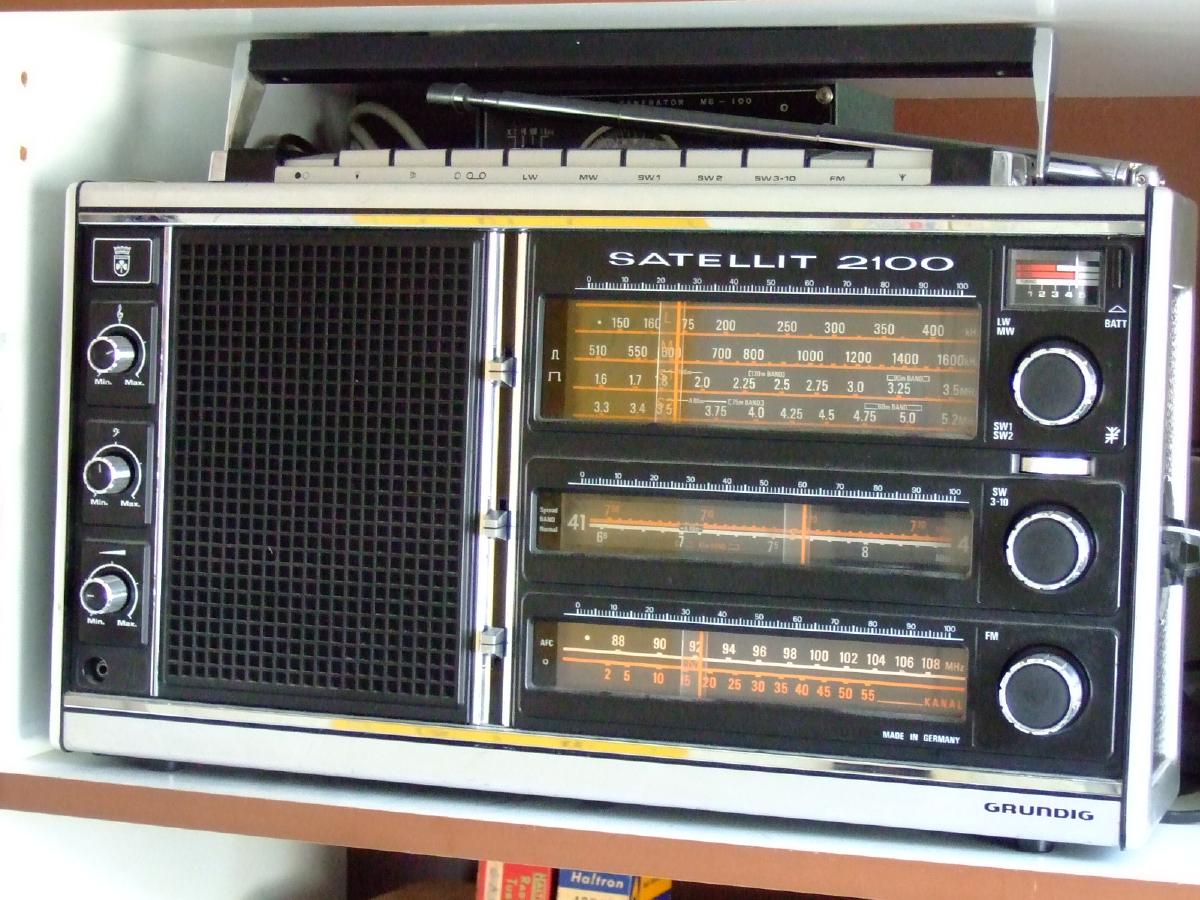Price was 1048 guilders catalogue price, 849 paid.
conductors
 Schema (original) plus service docs, dial chord diagram, purchase receipt, guarantee card, Consumers Union test.
Schema (original) plus service docs, dial chord diagram, purchase receipt, guarantee card, Consumers Union test.
359
Item nr.

Satellit receivers were top of the line in the seventies.
| Production | Germany, 1978.
Price was 1048 guilders catalogue price, 849 paid. |
|---|---|
| Bands | LW (150-400kHz), MW (510-1600kHz), SW1 (1.6-3.5MHz), SW2 (3.3-5.2MHz), SW3 (5.0-6.5MHz), 49m (5.9-6.25MHz), SW4 (6.6-8.4MHz), 41m (7.00-7.30MHz), SW5 (8.2-10.4MHz), 31m (9.40-9.95MHz), SW6 (10.5-13.2MHz), 25m (11.60-12.15MHz), SW7 (13.0-16.3 MHz), 19m (14.95- 15.70), SW8 (15.5-19.5MHz), 16m (17.4-18.15MHz), SW9 (18.5-23.0MHz), 13m (19,90-21.90MHz), SW10 (23.5-30MHz), 11m (25.4-26.5MHz), U/FM (88-108MHz). |
| Semi- conductors | 27 transistors and 14 diodes. |
| Cabinet | Plastic. Size 46x24x12 cm. Weight 6.3kg. |
| Power | AC or Batt (9V, 6xD). |
| Documents |  Schema (original) plus service docs, dial chord diagram, purchase receipt, guarantee card, Consumers Union test. Schema (original) plus service docs, dial chord diagram, purchase receipt, guarantee card, Consumers Union test. |
Spring 2013 was like a Satellite launch season for me. The Satellit 2000 I had for several years, I gave away after buying a Satellit 2100 at the Queen's Day flea market. That Satellit came with the SSB unit. Then I was offered this 2100 in even better state, so I sold the Queen's 2100. The success of the Satellit series followed pioneering radios like the Ocean Boys, of which I got myself the 204 in July 2013. In February 2022, I repaired a Satellit 2100.
 The user manual explains how you can even fix this set on board of a ship. Indeed, the Satellit 2100 was approved for use on board of some vessels.
The user manual explains how you can even fix this set on board of a ship. Indeed, the Satellit 2100 was approved for use on board of some vessels.
| Obtained | 6/2013 from Derk. |
|---|---|
| Condition | 9. |
| Value (est.) | 100€. |
| Sound sample | PLAY SOUND Grundigs are optimised for this language, here spoken from Radio Romania. It turns out that sometimes you can hear too much, at least in the eye of the people you hear. |

 The Short Wave bands (3 through 10) didn't work right away. Maarten, who had bought my other Satellit 2100, said that this was usually due to dirty contacts on the rotary band switch. So I opened the set (inside view is left) and cleansed the contacts with ammonia (right). Then the Short Waves worked like new.
The Short Wave bands (3 through 10) didn't work right away. Maarten, who had bought my other Satellit 2100, said that this was usually due to dirty contacts on the rotary band switch. So I opened the set (inside view is left) and cleansed the contacts with ammonia (right). Then the Short Waves worked like new.
 This set is now fully operational, complete with all knobs and the full dual purpose whip antenna, like explained in the advertisement in the Grundig Journal. It came with extensive original documentation, and I have the SSB Zusatz to overhear Single Side Band tranmissions, making this a valuable object.
This set is now fully operational, complete with all knobs and the full dual purpose whip antenna, like explained in the advertisement in the Grundig Journal. It came with extensive original documentation, and I have the SSB Zusatz to overhear Single Side Band tranmissions, making this a valuable object.
 In August 2014, the radio developed a switching problem: the MW pushbutton no longer came up when another wave switch was pressed. The photo on the left shows that the sections of the band switch are pushed up by metal springs, having grip around a small collar around the switch body (first section). The collar is plastic, and this material has the tendency to become brittle over time, and crumble. The MW collar had gone almost completely, resulting in the spring coming up without the switch section, and the SW1 collar was almost gone (second section). I could fix both sections by drilling a small hole (1mm) through the body and sticking a metal pin through it (third section).
In August 2014, the radio developed a switching problem: the MW pushbutton no longer came up when another wave switch was pressed. The photo on the left shows that the sections of the band switch are pushed up by metal springs, having grip around a small collar around the switch body (first section). The collar is plastic, and this material has the tendency to become brittle over time, and crumble. The MW collar had gone almost completely, resulting in the spring coming up without the switch section, and the SW1 collar was almost gone (second section). I could fix both sections by drilling a small hole (1mm) through the body and sticking a metal pin through it (third section). I hope the radio will be fine for some more time now. This incident teaches me that plastic brittling is a serious risk for the durability of plastic radios. Indeed, I have heard the same problem occurring in various sets. Andrés from South America found my site and succeeded to apply the same repair as described here to his radio (photo left).
I hope the radio will be fine for some more time now. This incident teaches me that plastic brittling is a serious risk for the durability of plastic radios. Indeed, I have heard the same problem occurring in various sets. Andrés from South America found my site and succeeded to apply the same repair as described here to his radio (photo left).